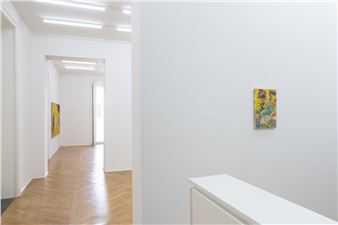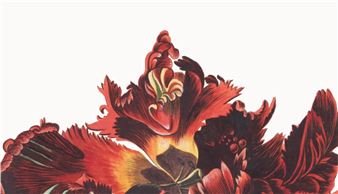Lin May Saeed: Arrival of the Animals
For the past fifteen years, Lin May Saeed (German, b. 1973) has focused on the lives of animals and human-animal relations. With empathy and wit, she tells stories, both ancient and modern, of animal subjugation, liberation, and harmonious cohabitation with humans, working toward a new iconography of interspecies solidarity.
Animals have arrived in the moral consciousness of many at the very moment of their mass extinction. The exhibition’s subtitle is borrowed from a short story of the same name by Elias Canetti. Saeed, whose roots are German-Jewish and Iraqi, appreciates Canetti’s writing for exposing power structures both within and among species. Many of Saeed’s animals arrive to reoccupy spaces that were once theirs; in other words, they return.
To imagine these worlds, Saeed often combines traditional artistic formats, such as the sculptural relief, with nontraditional materials, such as expanded polystyrene foam, better known as Styrofoam. This petroleum-based, non-biodegradable plastic is easy for the artist to find, usually secondhand, and to work, without assistance. For Saeed, Styrofoam is a reminder of humans’ environmental impact and thus a material ripe for transformation.
Saeed’s first museum solo exhibition surveys her drawings on and with paper as well as sculptures in Styrofoam, steel, and bronze. It is accompanied by the artist’s first monograph, published by the Clark and distributed by Yale University Press, which includes studio and installation photography, two interpretive essays, Saeed’s own writings, and a previously untranslated text on animality and otherness.

Recommended for you
For the past fifteen years, Lin May Saeed (German, b. 1973) has focused on the lives of animals and human-animal relations. With empathy and wit, she tells stories, both ancient and modern, of animal subjugation, liberation, and harmonious cohabitation with humans, working toward a new iconography of interspecies solidarity.
Animals have arrived in the moral consciousness of many at the very moment of their mass extinction. The exhibition’s subtitle is borrowed from a short story of the same name by Elias Canetti. Saeed, whose roots are German-Jewish and Iraqi, appreciates Canetti’s writing for exposing power structures both within and among species. Many of Saeed’s animals arrive to reoccupy spaces that were once theirs; in other words, they return.
To imagine these worlds, Saeed often combines traditional artistic formats, such as the sculptural relief, with nontraditional materials, such as expanded polystyrene foam, better known as Styrofoam. This petroleum-based, non-biodegradable plastic is easy for the artist to find, usually secondhand, and to work, without assistance. For Saeed, Styrofoam is a reminder of humans’ environmental impact and thus a material ripe for transformation.
Saeed’s first museum solo exhibition surveys her drawings on and with paper as well as sculptures in Styrofoam, steel, and bronze. It is accompanied by the artist’s first monograph, published by the Clark and distributed by Yale University Press, which includes studio and installation photography, two interpretive essays, Saeed’s own writings, and a previously untranslated text on animality and otherness.
Artists on show
Contact details

Related articles
The wait is over for art museums in Massachusetts, though not entirely and in bits and pieces scattered across the state. Such is life in the pandemic, but we’ll take it.
Pity the poor pangolin, in these desperately troubling times. It might not shoulder quite the blame of its tiny bat cousin for the coronavirus calamity still very much in progress (PSA: WEAR A MASK).
On a terrace of the Clark Art Institute’s hillside Lunder Center galleries stands a creature in white-painted bronze with the name Thaelab, or fox in Arabic.
When I first visited Lin May Saeed’s Berlin apartment/studio two years ago, the Iraqi-German artist and animal liberation activist was in the process of carving a polystyrene sculpture as two large rabbit roommates hopped around, enjoying the nontoxic snow-like flakes that...















